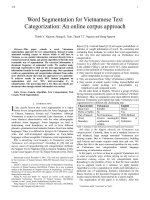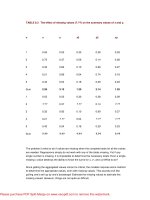Tài liệu Developmental Psychology for Family Law Professionals docx
Bạn đang xem bản rút gọn của tài liệu. Xem và tải ngay bản đầy đủ của tài liệu tại đây (1.66 MB, 406 trang )
Developmental
Psychology for Family
Law Professionals
Theory, Application, and the
Best Interests of the Child
Benjamin D. Garber, PhD, is a New Hampshire-licensed psychologist, state-certi-
fied guardian ad litem, practicing parenting coordinator, and expert consultant
to courts across the country. He is a nationally acclaimed speaker, an award-
winning popular press writer, and the author of numerous peer-reviewed profes-
sional publications in child development, mental health practice, and the law.
He is also is the author of Keeping Kids Out of the Middle: Child-Centered
Parenting in the Midst of Conflict, Separation, and Divorce (2008).
Across all of these professional roles and in writing this book, Dr. Garber
pursues the singular goal of helping families, communities, schools, and the
courts to better understand and respond to the developmental and systemic
needs of children. Learn more at www.healthyparent.com.
Developmental
Psychology
for Family
Law Professionals
Theory, Application, and the
Best Interests of the Child
BENJAMIN D. GARBER, PhD
New York
Copyright © 2010 Springer Publishing Company, LLC
All rights reserved.
No part of this publication may be reproduced, stored in a retrieval system, or transmitted
in any form or by any means, electronic, mechanical, photocopying, recording, or otherwise,
without the prior permission of Springer Publishing Company, LLC, or authorization through
payment of the appropriate fees to the Copyright Clearance Center, Inc., 222 Rosewood
Drive, Danvers, MA 01923; phone 978-750-8400, fax 978-646-8600, or
on the Web at www.copyright.com.
Springer Publishing Company, LLC
11 West 42nd Street
New York, NY 10036
www.springerpub.com
Acquisitions Editor: Jennifer Perillo
Production Editor: Pamela Lankas
Cover Design: Steve Pisano
Composition: International Graphic Services
Ebook ISBN: 978-0-8261-0526-4
10111213/54321
The author and the publisher of this Work have made every effort to use sources believed
to be reliable to provide information that is accurate and compatible with the standards
generally accepted at the time of publication. Because medical science is continually advanc-
ing, our knowledge base continues to expand. Therefore, as new information becomes
available, changes in procedures become necessary. We recommend that the reader always
consult current research and specific institutional policies before performing any clinical
procedure. The author and publisher shall not be liable for any special, consequential, or
exemplary damages resulting, in whole or in part, from the readers’ use of, or reliance on,
the information contained in this book. The publisher has no responsibility for the persistence
or accuracy of URLs for external or third-party Internet Web sites referred to in this
publication and does not guarantee that any content on such Web sites is, or will remain,
accurate or appropriate.
Readers are advised that no published work or generic source should ever be mistaken as
sufficient for understanding, diagnosing, or adjudicating a specific matter. This book only
offers general guidelines with which to understand certain areas of child and family develop-
ment and the means with which to apply these principles to certain family law matters.
Proper understanding of a specific individual’s needs calls for the careful administration of
direct, reliable, and valid assessment tools.
Library of Congress Cataloging-in-Publication Data
Garber, Benjamin D. (Benjamin David), 1959-
Developmental psychology for family law professionals : theory, application, and the best
interests of the child / Benjamin D. Garber.
p. cm.
Includes bibliographical references and index.
ISBN 978-0-8261-0525-7 (alk. paper)
1. Developmental psychology. 2. Families—Psychological aspects. 3. Parent and child.
4. Domestic relations. I. Title.
BF713.G365 2009
155.02’4346015—dc22 2009030047
Printed in the United States of America by The Hamilton Printing Company.
This volume is dedicated to you, the family court professional, who wades
patiently and skillfully through the raging tides of caregiver conflicts, who
faces the damage done by ignorant and ill and substance-abusing parents,
who endures the bottomless pit of paperwork and delay and who risks
sanity, no less than life and limb, confident that our children’s health and
happiness are worth all of this and more. May the blessing of even one
child’s smile carry you through many rough seas.
This book is dedicated, as well, to my three muses, Zoe, Mollie, and Laura,
not only for their insight, perspective, and feedback, but for sharing in the
profound and incomparable adventure of growing up together.
This page intentionally left blank
Contents
Preface ix
Acknowledgment xv
PART I: ONE SIZE CAN NEVER FIT ALL 1
1 Why a Perspective on Child and Family Development? 5
2 Caveat Lector: On the Limitations and Relevance of 19
Developmental Theory, Statistics, and Methods
PART II: DEVELOPMENTAL THEORY IN OVERVIEW 41
3 Cognitive Development 43
4 Language Development 55
5 Social and Emotional Development 69
6 The Child’s Defense Mechanisms: Regression, Stress, and 95
Impediments to Developmental Capacity
7 Developmental Asynchrony and De
´
calage 105
PART III: IN THE BEST DEVELOPMENTAL INTERESTS OF THE CHILD:
TOPICS IN SEPARATION, VISITATION, AND REUNIFICATION 141
8 A Child’s Understanding of Time, Separation, and Loss 143
9 Custodial Schedules and Infant Overnights 153
10 On Visitation Resistance and Refusal 165
11 Growing Up Apart: Child–Parent Separation 179
vii
viii
Contents
12 Development and Parent–Child Reunification 201
13 Development and the Termination of Parental Rights 215
PART IV: ADVANCED APPLICATIONS OF DEVELOPMENTAL
THEORY TO FAMILY LAW PRACTICE 227
14 What Is a “Mature Minor”? 229
15 Psychological Assessment and Diagnosis in Family Law 247
16 Alienation, Estrangement, and Alignment: The Tools and 263
Weapons of Affiliation
17 Development in the Mirror: On Becoming (and Remaining) 279
a Family Law Professional
APPENDICES
Appendix I: Learn More Now: Agencies, Organizations, and Experts 295
Appendix II: Preserving Families, Serving Children’s Needs, and 309
Building Our Shared Future: A Proposal for a National Program of
Continuing Parent Education
Appendix III: Select Resources for Involuntary Separation: 311
Incarcerated, Enlisted, or Hospitalized Parents
Appendix IV: Mentoring Youth: Anchoring Kids Cast Adrift 319
Appendix V: On Compassion Fatigue, Burnout, and 321
Vicarious Traumatization
References 325
Index 381
Preface
Developmental Psychology for Family Law Professionals: Theory, Applica-
tion, and the Best Interests of the Child is a practical application of
developmental theory to the practice of family law. It intends to help
you to ask questions that are developmentally informed and to better
understand the breadth of experience, reams of reports and depth of
emotion that must be digested in the course of seeking to understand
each child’s unique needs. It will provide you with new tools with which
you might better understand the developmental needs, synchronies, and
trajectories of children and—perhaps most critically—it will urge you
to see each child in terms of fit and growth. Ultimately, this book
seeks to guide you to recommend outcomes that anticipate changing
developmental needs.
Succeeding in these combined goals is intended first and foremost
to improve family court outcomes in the best interests of each child,
but may simultaneously improve the validity of your work and thereby
solidify your footing in deposition, as well as under direct and cross-
examination. To the extent that Developmental Psychology for Family
Law Professionals: Theory, Application, and the Best Interests of the Child
makes your work more scientifically based and your conclusions more
reliable and valid, you may be in better standing the next time an
injured and acrimonious parent brings you before a licensing board, a
malpractice hearing, or an appeals court (see chapter 17).
Succeeding in these goals may further benefit the courts and the
communities they serve by decreasing recidivist traffic. Developmentally
informed family court outcomes seek not only to fit children’s present
needs, but to implement outcomes that anticipate and account for
continuing growth. This may mean that revolving door litigants have
fewer reasons to return to court, can invest critical resources in their
children rather than their attorneys, and our courts’ tremendous backlog
and burden might thereby diminish.
ix
x
Preface
But Developmental Psychology for Family Law Professionals: Theory,
Application, and the Best Interests of the Child must not be misunderstood
to be a recipe book that can ever replace your own insights, intuitions,
compassion, and skill. In the best of circumstances, this book will serve
as reliable metric but, like the shoemaker’s tape measure, it remains
up to you when and where and how to apply it.
A WORD ABOUT WORDS
I’ve taken certain liberties in writing this book in the interests of making
an already complex subject a bit more readable and succinct, even if
perhaps a bit less politically correct. Here I would like to point out
certain choices in word usage, particularly as regards references to age
and developmental stage, gender (and family roles, both in case exam-
ples and in distinctions between developmental research and theory.
Age and Stage References
Some aspects of development are continuous over time (e.g., height).
Others are marked by qualitative shifts that are commonly referred to
as stages, as in “the terrible twos.” Many developmental theorists dis-
cussed in the pages to follow speak in terms of successive stages like
so many steps in a flight of stairs.
In the case of discontinuous growth, it is useful to refer to the onset
of a stage in terms of an associated landmark skill or capacity. Thus,
the stage of physical growth known as puberty is commonly marked
by specific physical “landmarks” (as measured by Tanner Stages, e.g.,
Sun et al., 2005). The same is true of stages of cognitive, social, and
emotional development, even if the landmark features are not as
readily apparent.
When stages of development are commonly associated with specific
chronological ages, those ages are stated. However, all such ages must
be understood to be approximations only: “Individuals differ consider-
ably in the timing of the development of psychosocial maturity, making
it difficult to define a chronological boundary between immaturity and
maturity” (Cauffman & Steinberg, 2000a, p. 758). Research demon-
strates time and again that the specific age at which a specific develop-
mental milestone appears can vary dramatically by individual, culture,
Preface
xi
language, opportunity, diet, and a host of other environmental variables.
Thus, “[even] for Piaget, the key element was the sequence, not the
age of cognitive transformations” (Lourenco & Machado, 1996, p.147).
The most valid and meaningful aspect of any such discussion will always
be the sequence of steps.
Even as approximations, references to specific developmental mile-
stones must further be understood to assume a full-term gestation of
40 weeks in utero. For example, a reference to the typical child beginning
to walk unassisted at twelve months in fact refers to twenty-one months
postconception. This is important in the case of the child born two
months prematurely whose first birthday actually occurs at nineteen
months post-conception and who, therefore, might look quite different
from his peers on their first birthdays.
Gender References
In telling the story of development and its application to family law
practice, references are made to boys and girls and caregivers of both
genders for ease of expression without implying anything specific to
either gender. For example, a child’s ability to tolerate separation from
a primary caregiver might begin with the phrase, “Her capacity to
maintain a secure internal image of the missing parent…” rather than
writing out the awkward “his/her” and “s/he.” However, there are a
number of sex-specific developmental differences. In these instances,
the distinction will be made explicitly, as in the statement, “Boys’ early
gross motor development typically precedes that of female age mates.”
Family Role References
Again, for ease of reference, the hypothetical families who populate
this book are framed in the terms of a conventional, heterosexual,
married, “Leave it to Beaver” family structure. Thus, children are dis-
cussed in relationship to one mother and one father, paternal relatives
and maternal relatives. In fact, the research literature upon which this
book is based is more or less explicitly limited to exactly this population.
Nevertheless, this book intends no such bias. To the fullest extent
possible, the family law matters discussed here are intended to apply
to children and their caregivers regardless of race, religion, culture,
xii
Preface
gender, age, generation, sexual orientation, and/or the legal status of
the adult relationship or of the caregiver–child relationship.
This means that, unless specifically noted to the contrary, a discus-
sion of a child’s attachment to his mother can reasonably be generalized
to apply to the quality of the relationship between a little girl and her
foster or adoptive father. By the same token, a discussion about the
quality of communication between coparents will most commonly refer
to a heterosexual married—or previously married—couple, but is rea-
sonably generalized to apply to any pair of adults who share the primary
responsibility for a child. These generalizations are expected and en-
couraged, with the caveat that they probably go beyond the research
data that informs them.
I also note that I write at a time of transition in family law. Where
terms like “custody” and “visitation” were ubiquitous 10 years ago,
they are slowly being replaced by more awkward but politically correct
terms such as “parenting rights and responsibilities” and “parenting
time,” respectively. In the interests of readability and space, I intermix
these terms as I see fit, never intending to connote ownership as might
be inferred from the word “custody” or irrelevance and disinterest as
might be associated with “visitation.”
Specifically, in the text that follows, the “custodial parent” and the
“residential parent” are interchangeable references to the adult who is
vested by court order (or by happenstance) with day-to-day decision-
making responsibility for a child. The “parent on duty” (or POD) is
the adult who has the immediate responsibility for the child’s care.
Finally, in the context of transition between two caregivers, as com-
monly occurs between separated and divorced parents or between a
foster and a birth parent, the “sending parent” is the adult who is giving
up POD responsibility and the “receiving parent” is the adult who is
accepting POD status.
Case Examples
When it seems useful, I have taken the liberty of illustrating the applica-
tion of developmental principles with hypothetical and fictitious case
examples, derived from my experience and that of collaborating col-
leagues. In every instance, relevant details have been changed to protect
confidentiality and privilege, except when case law is cited. Even in
Preface
xiii
these latter, precedent-setting instances, we must agree that the real
children’s lives, must never be unduly exploited or publicized.
REFERENCES, CITATIONS, AND
RESOURCES IN THIS BOOK
Developmental Psychology for Family Law Professionals: Theory, Applica-
tion, and the Best Interests of the Child provides you, the front-line family
law professional, with the relevant and up-to-date data with which to
make developmentally informed, systemically oriented, and therapeutic
recommendations in the best interests of the child. However, it is
impossible for any single text, or compendium of texts, to discuss all
that is known about child development, let alone apply this data to a field
as diverse and provocative as family law. In this regard, Developmental
Psychology for Family Law Professionals must not stand on its own.
This book simply cannot adequately do the job that it intends between
two covers.
Professional ethics, relevant procedural guidelines and particular
court preferences commonly mandate that our work be grounded in
relevant, peer-reviewed, empirical research (e.g., Gould & Martindale,
2008). In service of this goal, Developmental Psychology for Family Law
Professionals is peppered with a tremendous number and great breadth
of links to further information. Citations to up-to-date literature are
provided wherever possible. Separate bibliographies of relevant re-
sources are devoted to several topics deserving of attention far greater
than what I can provide. Direction to relevant associations, agencies, and
Web sites appear throughout the text and are summarized in Appendix I.
Copious footnotes elaborate and provide alternate interpretations and
competing ideas. At the potential risk of interrupting the flow of the
text, these links intend to empower you to go far beyond this text, to
learn more about the particular issues that arise in a particular case, and
thereby to better understand and fulfill the needs of each unique child.
Children are not well served if social policy is based on lawyers’ opinions and
judges’ instincts or the views of advocacy groups, rather thanon the sound
foundation of knowledge actually available.
—Leslie Shear et al., Amici curiae brief, In re Marriage of LaMusga
xiv
Preface
[B]y what manifesto was the family law bench imbued with greater wisdom
and knowledge about the children than that possessed by the consenting
parents themselves?
—Tom Altobelli, Federal Magistrate, Sydney, Australia
Acknowledgments
I am indebted beyond words to Zoe, Mollie, and Laura for the emotional
support, encouragement, and patience that allows me not only to work
as a family law professional myself, but to carve out the time to write
about the experience. If there is any gratitude due for the lessons this
book seeks to impart, it is due to these three amazing women.
To Janice Pieroni of Story Arts Management (Boston, Massachu-
setts): My undying gratitude for insight, skill, resourcefulness, support,
and the often necessary kick-in-the-pants, above and beyond the call
of duty.
Any errors contained within this book are entirely my own. How-
ever, any benefits that might accrue from this book are entirely to the
credit of the generous souls who have shared their hopes and dreams,
pain and joy in the best interests of their children.
Eeyore was saying to himself,
“This writing business.
Pencils and what-not.
Over-rated, if you ask me.
Silly stuff. Nothing in it.”
—Winnie the Pooh
xv
This page intentionally left blank
PART
I
One Size Can Never
Fit All
Mothers of more than one child will tell you that no two children can be
brought up alike. Everybody knows that this is true. Yet when our children
reach school age, for the sake of convenience we assume that their mental
natures can be brought up exactly alike, and we turn them over to school
with a cheerful carelessness that, when one stops to consider, is just a little
difficult to explain.
—Alice Grant
A presumption which applies a “one size fits all” approach does a disservice
to the legitimate needs of children to be heard and to experience high quality
post-separation parenting.
—Family Law Council of Australia
It is a failing of our professional training and our family courts alike
that the tremendous breadth and depth of developmental research has
no necessary and organized place in child-centered forensic decisions.
The pages that follow seek to repair this schism by addressing a succes-
2
Part I
sion of familiar child-centered legal questions from a developmental
perspective.
But perhaps the gap between research and courtroom, like the
mythical river Styx, is a necessary and intentional boundary. Perhaps
this schism is planned and functional, keeping empiricists and jurists,
theorists and attorneys on opposite shores. If so, then what I have
construed here as a systemic weakness may, in fact, be a useful division
which, were it bridged, would somehow contaminate or undermine the
work of those on one or both sides of the divide.
It is true that our legal system depends heavily on judicial discretion
and case law precedent (Bradbrook, 1971; Emery, 1999). But is it,
therefore, also true that the introduction of an empirically based struc-
ture with which to guide legal outcomes risks compromising judges’
authority and litigants’ due process rights? To this I respond respectfully
that the best interests of the child must trump all else. To operate our
family courts intentionally ignorant of relevant and reliable data is to
fail not only to meet a “best interests” threshold, but to fail to serve
our future, as well. Thus, I recommend the incorporation of empirically
sound research into child-centered forensic outcomes. In taking this
stand, I am by no means alone. Glendon (1986, p. 59), for example,
voices a similar position quite clearly: “[I]n divorce law, the traditional
stronghold of judicial discretion, the judge’s discretionary power should
be brought within a framework of clear, ordered and consistent
principles.”
By grounding family law processes in developmental theory and
research, one may ask, aren’t we taking the first, fatal first step down
the slippery slope toward automating judicial outcomes? Doesn’t this
discussion ultimately ignore the individual child, curtail judicial discre-
tion, and necessarily lead to heuristic-driven, generic decisions akin to
custody under the laws of chattel?
No. Having learned to value the child as an individual—not as
property—we can never, in good conscience, turn back. For better or
worse, our jobs are secure. The need is simply too great, the permuta-
tions on each motion too many and the research far from complete.
The applications of developmental theory and research that follow will
provide you, the family law professional, with firmer ground to stand
upon as you seek to understand and respond to each child’s unique
needs, but must not be misconstrued as prescribing generic answers
by age.
One Size Can Never Fit All
3
Among the the issues addressed in Part I:
■ Why not all developmental research is created equal
■ The importance of context: How does developmental research
apply to the child sitting in front of you?
■ Does developmental research meet Daubert standards?
The chapters that follow can only inform forensic investigation and
judicial discretion, never supplant them. The simple breath-taking real-
ity underlying all of our work is that each child is an individual unlike
all others, growing up in a unique constellation of relationships and
resources, opportunities and crises, strengths and weaknesses—that, in
fact, one size will never fit all.
This page intentionally left blank
1
Why a Perspective on Child and
Family Development?
[L]aw guardians and guardians ad litem ought to be well trained in family
law and have some meaningful education in child development, rather than
a course consisting of a lecture of a few hours with no measure of comprehen-
sion or capacity.
—Patricia Ann Grant and Steven Klee
Family law professionals and shoemakers have at least two things in
common. First and foremost, both are concerned with “fit.” The shoe-
maker measures the tangible dimensions of the foot with tools that are
readily available. Tape measure. A black and silver mechanism known
as a Brannock Device. With a steady hand, a little training, and a lot
of experience, the shoemaker can reliably fit any individual’s unique
need for footwear.
Across guilds and training and jurisdictions, family law profession-
als share an interest in doing something quite similar. As family law
attorneys, mediators, guardians ad litem, parenting coordinators, child
protection workers and jurists, we are working to tailor family circum-
stances to fit a child’s unique needs. We are tasked to cobble together
parenting resources, caregiving environments, social supports, educa-
tional opportunities, and therapies to serve the child’s best interests.
5
6
Part I One Size Can Never Fit All
Unlike the shoemaker, we don’t have a uniform set of reliable and
meaningful tools with which to do our work. As a result, we individually
gravitate toward whatever collection of instruments and processes and
impressions our training and experience and the practical limits inherent
in our work setting provide us. Unfortunately, these tools tend to be
borrowed from other endeavors and can be all-too blunt. Few have an
empirically established relationship to the questions we are seeking to
answer or even the consensual validation of our peers.
Worse, we’re seldom certain what to measure (Tippins & Wittman,
2005). Although the shoemaker can identify the dimensions from heel
to toe, around the arch and across the width of the foot, we speak
blithely about “needs” and “best interests,” concepts that are at least
as ill-defined as they are overused. True, some relevant defining criteria
have been legislated,
1
even if they’ve never actually been empirically
tested. But even these efforts to make our measurements more specific
leave us to juggle a handful of competing ideas and opinions, uncertain
what they mean and how they are weighted.
Shoemakers and family law professionals share a second common
interest in growth. No one is ever surprised when a child’s foot grows,
yet we have never created a shoe that will adjust accordingly. Instead,
the ritual of shoe-shopping is for some as frequent and expectable as
the change of the seasons. Shoemakers, of course, thrive in this way.
Their business depends in large part upon refitting children over and
over again across time.
In the same way that the shoemaker might anticipate foot growth,
we are generally able to anticipate the pace and trajectory of a child’s
social and emotional growth. We have the means to foresee the child’s
faltering movement toward autonomy, his or her burgeoning capacity
for cognitive abstraction, and ever-expanding social investments. We
know a great deal about the environments that are most likely to foster
these healthy changes and those which are likely to impede them. But,
like the shoemaker, we seldom craft outcomes that adequately anticipate
this growth.
This failing is not an entrepreneurial strategy intended to keep our
calendars busy and our bank accounts full. The tragic reality of our
times is that if every family law professional could magically dispense
with each case in a single day, our days would still be full. Nationally,
the demand for services that span the spectrum of family law is endless.
Divorce runs rampant. Custody matters can seem never-ending. The
Chapter 1 Why a Perspective on Child and Family Development?
7
horror of child abuse and neglect and the litigation associated with
foster care, termination of parental rights, and adoption is a business
unto itself. Our courtrooms are bursting at the seams. Tragically, a 5-
year-old caught up in family litigation will spend no less than 20% of
her young life being dragged through the courts.
2
In fact, the family court system’s failure to craft developmentally
informed decisions is the result of precisely the sort of conflict that it
exists to resolve. As in so many troubled families, the academic “parent”
and the judicial “parent” never really learned to communicate. Each
ignores the other at a cost to both, but none so much as their “child,”
namely, the litigating family.
Those of us who see the harm done by a court system that decides
matters of parenting rights and custodial responsibilities with no clear
and consistent understanding of fit and growth, those of us who see
the damage done to children whose caregivers are stuck in revolving-
door litigation, and those of us who seek to better understand what is
truly in each child’s best interests must now discover developmental
psychology and its application to family law matters.
This chapter collapses the first seven or eight lectures from a college-
level developmental psychology course into a few pages. This is essential
reading for those who have never taken the opportunity to consider
why development is important, how change unfolds over time, and
how the growing child must be understood as one part of a growing,
changing, and—in the cases of immediate concern—conflicted family
system. This is the foundation on which we can begin to ask the
questions that inform this book and, most immediately, the conflict
that can arise when a child’s needs and those of his or her family are
at odds.
THE PURPOSE OF DEVELOPMENTAL PSYCHOLOGY
If psychiatry is the offspring of Freud and the stepchild of today’s drug
companies, psychology might best be considered its half brother. Born
of William James and Hermann Ebbinghaus, fostered by Pavlov and
Binet, by Watson and Skinner, psychology’s roots are far more deeply
embedded in measurement and research than in clinics and hospitals.
In fact, at least half of all doctoral level psychologists’ full-time employ-
ment is not in a direct service environment.
3
Psychology’s longest stand-
8
Part I One Size Can Never Fit All
ing and most significant contribution rests in its accumulated empirical
understanding of human growth, behavior, thinking, and feeling.
Put aside your preconceptions of Freudian analysts and their
couches. The psychologist-cum-researcher is a scientist who defines a
narrow question of interest, gathers a selection of people who are
believed to fairly represent the larger population at issue, administers
standardized measures, and then interprets the collected data in an
effort to make generalizations that add incrementally to an accumulating
understanding of the species.
Developmental psychology research asks questions about change
over time and the contexts that foster or inhibit it; about the unfolding,
up-and-down, back-and-forth progression of maturation from concep-
tion through adulthood that defines the growth of thinking, feeling,
behavior and relationships. Such as:
■ How do children learn language?
■ Are there gender differences in the development of self-recogni-
tion among infants?
■ Do the elderly lose cognitive abilities or perform more slowly?
The accumulated result of tens of thousands of such endeavors spanning
the last century has created a vast (but far from complete) body of
knowledge accounting for the direction, landmarks, and vicissitudes of
human growth from conception onward. This book seeks to apply this
invaluable data to the questions that come before family courts.
THE VALUE OF THE INDIVIDUAL
It is both a blessing and a burden that twenty-first century Western
society values the individual apart from the group. The blessing is heard
in countless stories celebrating individuals whose perseverance and
commitment and skills allowed them to stand out among their peers.
Think Rosa Parks, Helen Keller, Stephen Hawking, or Sandy Kofax. It
is highlighted in countless moral dilemmas posed to thoughtful students
of philosophy in which the value of an individual is weighed against
that of a larger group.
4
We explicitly nurture the ethic that anyone can
succeed and that everyone deserves a fair chance, no matter the situation.
We mandate that “no child be left behind.” We pass laws and enact









